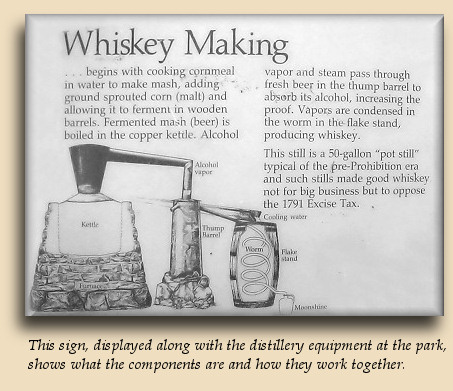May 2, 2003
The farmers who continued distilling ("by the light of the
moon") their own produce for their own use during the late 18th and early
19th centuries were simply dealing with an unworkable situation as best they
could. The authorities, of course, took a dim view of
moonshining. The Frederick County sheriff's department mounted a series of
raids on stills nestled in the mountains between Thurmont and Foxville. One
of those sites, known as Blue Blazes, was set near Harman's Creek, five
miles west of Thurmont. The Frederick Post reported that Blue Blazes Still
was "one of the largest and best equipped in Frederick County" It was a
"steamer"
There is not a trace left of the original moonshine
distillery, of course, but in 1970 the Park Service built a
mountain distillery
exhibit on the site, with a working model of a much smaller still.
That is, it WAS a working model. The Park Service doesn't actually fire it
up anymore, but they used to until around 1989.
The notorious excise tax of 1791 that brought about the
Whiskey Rebellion really only lasted for eleven years.
The small distillery operated in Perryopolis by Israel
Shreve was basically the same kind of distillery as this one, only set up
indoors in a stone building. It's likely that the family still that
Abraham Overholt's father operated at their West Overton farm was also
similar in size and style. Shreve's distillery was associated with his
grist mill, and provided distilling services for a fee. Overholt's began
that way, but around 1810 son Abraham transformed the operation into one
that focused on wholesaling the whiskey itself as an end product. The new
trend among commercial distillers was to redefine the grain farmer as a
vendor, rather than as a customer. Instead of paying to have his grain
made into whiskey, the farmer could now take his grain to the distillery
or mill and get cash for it. This was a win-win situation that continued
even after the excise tax no longer existed.
Individual farm distilleries like this one might have
vanished altogether then, except for three factors...
(1) Of course there were always (and still are)
some subsistence farmers whose products serve their immediate family or
can be used for limited trade with bartering partners. However, since
subsistence farmers normally cherish their independence from the general
community, their distilling equipment and methods didn't have a great deal
of effect upon American whiskey distilling as a whole.
(2) Another distilling trend that was gaining favor
involved companies that would purchase farmers' distilled product directly
and then vat them all together, adjusting as needed to compensate for
differences in strength and quality. This is exactly the way such other
agricultural organizations as dairy or fruit cooperatives worked and still
do. In such cases, of course, the individual farmers retained and operated
their small stills, selling only their end product to the distillery.
(3) The tax-free status of whiskeymaking ended with
the onset of the Civil War, and has never returned since then. Once the
excise taxes were returned to the equation, the cost advantages of illicit
production make moonshining profitable. It was really this period between
the Civil War and the beginning of prohibition in the 1920s from which we
get most of our popular images about the hillbilly moonshiners. Once the
production of alcohol was outlawed altogether, the bootleg still of the
'20s and '30s was a much different affair, typically far larger and
operated by far less reputable distillers than had been the case earlier.
Nevertheless, there were stealth advantages in the type of small, easily
set up and taken down operation the old-style farm still provided. Thus,
many of the old pot stills and worms we find in museums, including the
still here at Catoctin and the one displayed at Shreve's, are really old
moonshiners' equipment that might have been still in use in the 1960s.
Click here and
we'll visit the 1790s distillery operated in Pennsylvania by Israel
Shreve...
.
American
Whiskey:
Catoctin
National Park:
Okay, so it's not quite the
Blue Blazes
still...
But it could have been its great-great-grandfather
![]()
FARMERS BEGAN SETTLING the area around
Frederick County, Maryland as early as 1734, and until the
United States Congress passed the 1791 Excise Tax laws, just about every
farm had its own whiskey-distilling apparatus. Even afterwards, it was
perfectly legal to own and operate a still -- provided you registered it
with the Federal government and paid the tax.
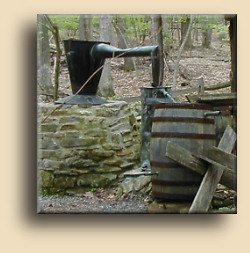 It wasn't until passage of the
Eighteenth Amendment to the Constitution in 1919 that mere possession of
distilling equipment became a crime. Problem was, in the 18th century, even
if an individual farmer were conscientious about registering his farm's tiny
single still, he had no way to obtain money to pay the tax with. Most of
what a farmer received for selling his surplus crop was in the form of
traded goods and services, and the law required the tax to be paid in United
States currency. The only distillers who could dependably obtain currency
were those producing whiskey on a large enough scale to sell it
commercially.
Of course there were farmers who chose to continue making whiskey
without bothering to register and pay taxes, but over time most found it not
too inconvenient to take their grain to a nearby commercial distillery.
It wasn't until passage of the
Eighteenth Amendment to the Constitution in 1919 that mere possession of
distilling equipment became a crime. Problem was, in the 18th century, even
if an individual farmer were conscientious about registering his farm's tiny
single still, he had no way to obtain money to pay the tax with. Most of
what a farmer received for selling his surplus crop was in the form of
traded goods and services, and the law required the tax to be paid in United
States currency. The only distillers who could dependably obtain currency
were those producing whiskey on a large enough scale to sell it
commercially.
Of course there were farmers who chose to continue making whiskey
without bothering to register and pay taxes, but over time most found it not
too inconvenient to take their grain to a nearby commercial distillery.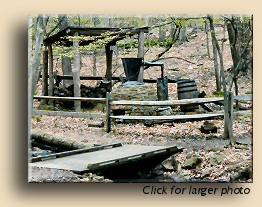 They were also upholding a long colonial tradition of ignoring laws that
didn't suit them. The onset of National Prohibition in 1919, though, brought
an entirely new and different type of distiller into such hard-to-find
places as the Catoctin Mountains around Thurmont, Maryland. These
whiskeymakers were not distilling for subsistence; they were producing
spirits illegally on a large scale, for profit. The going price for "white
lightening" quickly went from around two dollars a gallon to twenty-two.
According to a National Park Service publication, distilling alcohol became
big business in the Catoctin mountains. The mountain provided a secluded
protected area with ready sources of water. Meanwhile, using nearby roads,
moonshiners could ship their product to Baltimore or Washington within a
couple of hours.
They were also upholding a long colonial tradition of ignoring laws that
didn't suit them. The onset of National Prohibition in 1919, though, brought
an entirely new and different type of distiller into such hard-to-find
places as the Catoctin Mountains around Thurmont, Maryland. These
whiskeymakers were not distilling for subsistence; they were producing
spirits illegally on a large scale, for profit. The going price for "white
lightening" quickly went from around two dollars a gallon to twenty-two.
According to a National Park Service publication, distilling alcohol became
big business in the Catoctin mountains. The mountain provided a secluded
protected area with ready sources of water. Meanwhile, using nearby roads,
moonshiners could ship their product to Baltimore or Washington within a
couple of hours.
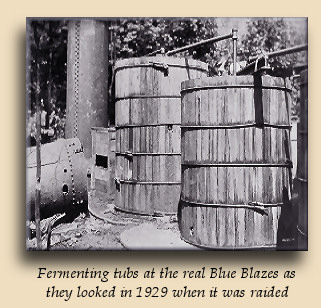 Very
quickly, local moonshine gained a national reputation, and one might by
surprised at how well-known was the high quality of Catoctin moonshine, even
as far away as New York City.
Very
quickly, local moonshine gained a national reputation, and one might by
surprised at how well-known was the high quality of Catoctin moonshine, even
as far away as New York City. type
of still, with a boiler from a steam locomotive, two condensing coils, a
cooling box, and no less than thirteen 2,000-gallon fermenting vats. The
operation was large enough to meet the illegal whiskey needs of Baltimore,
Washington DC, and Philadelphia. It earned both it's eternal notoriety and
its demise during a tragic raid in July of 1929 that resulted in the murder
of a deputy sheriff. The
National Park Service has a well-detailed story at this location.
type
of still, with a boiler from a steam locomotive, two condensing coils, a
cooling box, and no less than thirteen 2,000-gallon fermenting vats. The
operation was large enough to meet the illegal whiskey needs of Baltimore,
Washington DC, and Philadelphia. It earned both it's eternal notoriety and
its demise during a tragic raid in July of 1929 that resulted in the murder
of a deputy sheriff. The
National Park Service has a well-detailed story at this location.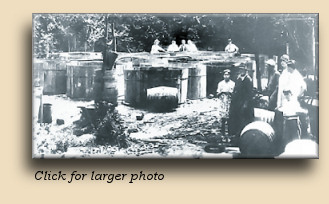 Today, they only tell
stories, and even then, only occasionally. But at least they recognize the
existence of both whiskeymaking and moonshining and their importance to the
history of American people. The display, located outdoors in a natural
setting, has been put together quite nicely. The still itself is very
small, about a 50-gallon-capacity unit. It looks the way most people would
imagine a hillbilly moonshine still to look; what you might see in Li'l
Abner or on The Beverly Hillbillies. That's a far cry from the original Blue
Blazes, which looked like a train wreck and produced batches of 2,000
gallons at a time. The exhibit is really a better example of the sort of
personal still a 19th century farmer might have used as general farm
equipment, and that, rather than glorifying the actual Blue Blazes criminal
site, was probably their intent. As such, it's a very good display. We only
wish it were still huffing and puffing.
Today, they only tell
stories, and even then, only occasionally. But at least they recognize the
existence of both whiskeymaking and moonshining and their importance to the
history of American people. The display, located outdoors in a natural
setting, has been put together quite nicely. The still itself is very
small, about a 50-gallon-capacity unit. It looks the way most people would
imagine a hillbilly moonshine still to look; what you might see in Li'l
Abner or on The Beverly Hillbillies. That's a far cry from the original Blue
Blazes, which looked like a train wreck and produced batches of 2,000
gallons at a time. The exhibit is really a better example of the sort of
personal still a 19th century farmer might have used as general farm
equipment, and that, rather than glorifying the actual Blue Blazes criminal
site, was probably their intent. As such, it's a very good display. We only
wish it were still huffing and puffing.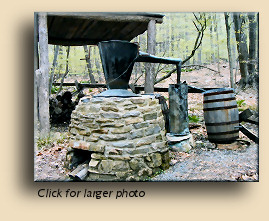 During that time, individual farm stills such as the one we see here at
Catoctin may have been operated illegally in the sense of being
unlicensed, but more and more distilling, even by small farmers, was being
done by larger (and licensed) distillers or as a service offered by the
grain mills. Thus, by 1802, when newly-elected president Thomas Jefferson
repealed the excise tax, most farmers were already enjoying the advantages
of patronizing commercial distillers and continued to favor using them.
During that time, individual farm stills such as the one we see here at
Catoctin may have been operated illegally in the sense of being
unlicensed, but more and more distilling, even by small farmers, was being
done by larger (and licensed) distillers or as a service offered by the
grain mills. Thus, by 1802, when newly-elected president Thomas Jefferson
repealed the excise tax, most farmers were already enjoying the advantages
of patronizing commercial distillers and continued to favor using them.